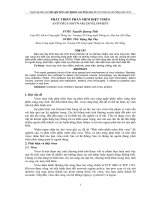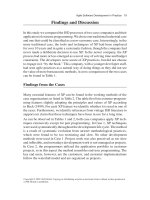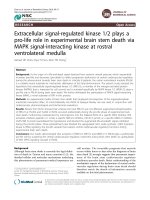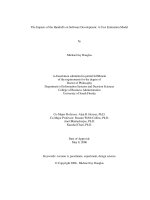Assignment 2 1631 Software Development Life Cycles
Bạn đang xem bản rút gọn của tài liệu. Xem và tải ngay bản đầy đủ của tài liệu tại đây (2.71 MB, 73 trang )
ASSIGNMENT 02 FRONT SHEET
Qualification
BTEC Level 5 HND Diploma in Computing
Unit number and title
Unit 09: Software Development Life Cycle
Submission date
14/06/2023
Date Received 1st submission
15/06/2023
Re-submission Date
28/06/2023
Date Received 2nd submission
28/06/2023
Student Name
Tran Duc Long
Student ID
GCH210562
Class
GCH1106
Assessor name
Nguyen The Lam Tung
Student declaration
I certify that the assignment submission is entirely my own work and I fully understand the consequences of plagiarism. I understand that making a
false declaration is a form of malpractice.
Student’s signature
Grading grid
P5
P6
P7
M3
M4
Page 1 of 72
M5
M6
D3
D4
❒ Summative Feedback:
❒ Resubmission Feedback:
2.1
Grade:
Assessor Signature:
Date:
Internal Verifier’s Comments:
Signature & Date:
Page 2 of 72
Table of Contents
A. Introduction..................................................................................................................................................................................................................... 7
B. Task 1: Analysis (1) ........................................................................................................................................................................................................ 7
Identify the stakeholders, their roles and interests in the case study. ......................................................................................................................... 7
I.
1.1.
What is stakeholder? ............................................................................................................................................................................................ 7
1.2.
Types of stakeholders .......................................................................................................................................................................................... 8
1.3.
Roles of Stakeholders .......................................................................................................................................................................................... 9
1.4.
Stakeholder role with interest in Tune Source Project ........................................................................................................................................ 9
1.5.
Stakeholder requirements .................................................................................................................................................................................. 11
1.6.
Indentify FRs and NFRs of Tune Source Project .............................................................................................................................................. 12
1.6.1.
Function requirements.................................................................................................................................................................................... 12
1.6.2.
Non Function requirements ............................................................................................................................................................................ 13
Discuss the relationships between the FRs and NFRs ....................................................................................................................................... 15
1.7.
II. Discuss the technique(s) you would use to obtain the requirements. ....................................................................................................................... 17
Some approach/ technique (es) suitable for the project ..................................................................................................................................... 17
2.1.
2.1.1.
Joint Application Development (JAD). ......................................................................................................................................................... 17
2.1.2.
Interview ........................................................................................................................................................................................................ 19
2.1.3.
Observation .................................................................................................................................................................................................... 21
2.2.
Apply for Tune Source project .......................................................................................................................................................................... 23
a.
JAD ....................................................................................................................................................................................................................... 25
b.
Interview............................................................................................................................................................................................................... 26
Page 3 of 72
C. Task 2: Analysis (2) ...................................................................................................................................................................................................... 29
Use case Diagram for the system .............................................................................................................................................................................. 29
I.
1.1.
Use-case diagram ............................................................................................................................................................................................... 29
II. Use case specification for 2 use cases ....................................................................................................................................................................... 32
2.1.
Search Songs ...................................................................................................................................................................................................... 32
2.2.
Payment song ..................................................................................................................................................................................................... 34
III.
Context Diagram ................................................................................................................................................................................................... 36
IV.
Entity-Relationship Model (ERD)......................................................................................................................................................................... 40
D. Task 3: Design .............................................................................................................................................................................................................. 46
Discuss how the user and software requirements are addressed in the design phase. .............................................................................................. 46
I.
1.
Wireframe .............................................................................................................................................................................................................. 46
a.
Manage Songs ....................................................................................................................................................................................................... 46
b.
Register and Login ................................................................................................................................................................................................ 47
c.
Home ..................................................................................................................................................................................................................... 48
d.
Detail song ............................................................................................................................................................................................................. 49
e.
Cart ........................................................................................................................................................................................................................ 50
f.
Check out ............................................................................................................................................................................................................... 51
2.
Architecture (Mock-up) ......................................................................................................................................................................................... 52
a.
Mock-up of system website................................................................................................................................................................................... 53
b.
Song management ................................................................................................................................................................................................. 55
c.
Register and login .................................................................................................................................................................................................. 55
Page 4 of 72
d.
Home page ............................................................................................................................................................................................................. 56
e.
Song detail ............................................................................................................................................................................................................. 59
f.
Cart ........................................................................................................................................................................................................................ 59
g.
Check out ............................................................................................................................................................................................................... 60
3.
Architecture is suitable in the project .................................................................................................................................................................... 62
3.1.
Server-client ....................................................................................................................................................................................................... 62
3.2.
N-tier .................................................................................................................................................................................................................. 62
3.3.
Microservice ...................................................................................................................................................................................................... 63
3.4.
Apply designs to Tune source project ............................................................................................................................................................... 64
4.
Technical solution stack could be suitable to implement the project with clear explanations. ............................................................................. 68
E. Conclusion .................................................................................................................................................................................................................... 70
F.
References..................................................................................................................................................................................................................... 70
Page 5 of 72
Table of Figures
Figure 1: Stakeholders (Landau, 2022). ................................................................................................................................................................................. 7
Figure 2: FRs and NFRs (Anon, 2023) ................................................................................................................................................................................... 16
Figure 3: Admin use-case diagram ....................................................................................................................................................................................... 30
Figure 4: Context diagram for the whole system ................................................................................................................................................................ 37
Figure 5: Data Flow Diagram - Level 0 for the whole system .............................................................................................................................................. 39
Figure 6: ERD of Tune Source website ................................................................................................................................................................................. 41
Figure 7: Songs management wireframe ............................................................................................................................................................................. 47
Figure 8: Wireframe register and login ................................................................................................................................................................................ 48
Figure 9: Home wireframe ................................................................................................................................................................................................... 49
Figure 10: Detail song wireframe ......................................................................................................................................................................................... 50
Figure 11: Cart wireframe .................................................................................................................................................................................................... 51
Figure 12: Check out wireframe........................................................................................................................................................................................... 52
Figure 13: Mokup of system website Tune Soucre .............................................................................................................................................................. 54
Figure 14: Song management .............................................................................................................................................................................................. 55
Figure 15: Register and login to Website ............................................................................................................................................................................. 56
Figure 16: Home page TuneSource ...................................................................................................................................................................................... 58
Figure 17: Song detail page .................................................................................................................................................................................................. 59
Figure 18: Add to cart .......................................................................................................................................................................................................... 60
Figure 19: Check out page .................................................................................................................................................................................................... 61
Figure 20: Client-server ........................................................................................................................................................................................................ 62
Figure 21: N-tier ................................................................................................................................................................................................................... 63
Figure 22: Microservices ...................................................................................................................................................................................................... 64
Figure 23: LAMP stack .......................................................................................................................................................................................................... 68
Page 6 of 72
A.
Introduction
The Software Development Life Cycle (SDLC) is a systematic approach employed by organizations to develop and implement software
systems of exceptional quality. It offers a framework for overseeing the complete software development process, starting from initial
planning and requirement gathering to the final stages of deployment and maintenance. By utilizing software development lifecycle
management (SDLC), projects can be carried out successfully, with clear objectives, efficient communication, and a focus on delivering
value to stakeholders.
B.
I.
Task 1: Analysis (1)
Identify the stakeholders, their roles and interests in the case study.
1.1. What is stakeholder?
A stakeholder is an individual, group, or organization that has an interest or concern in a particular project, company, or system.
Stakeholders can have various roles and levels of influence, and they can be both internal and external to the organization.
(Landau, 2022).
Figure 1: Stakeholders (Landau, 2022).
Page 7 of 72
Internal stakeholders typically include individuals or groups within the organization, such as employees, managers, shareholders,
and board members. They have a direct connection to the project or organization and are directly affected by its outcomes.
External stakeholders, on the other hand, are individuals or groups outside the organization who can be impacted by its actions
or decisions. They may include customers, suppliers, government agencies, local communities, investors, and advocacy groups.
These stakeholders often have indirect relationships with the organization but can still significantly influence its operations and
success.
Stakeholders have different interests, needs, and expectations, and it is important for organizations to identify and engage with
them effectively. By considering stakeholder perspectives and involving them in decision-making processes, organizations can
manage their interests, mitigate risks, and build positive relationships to achieve their goals. Effective stakeholder management
is crucial for ensuring transparency, accountability, and long-term sustainability. (Landau, 2022).
1.2. Types of stakeholders
Stakeholders can be classified into various types based on their relationship to an organization or project. Here are some
common types of stakeholders:
• Customers: Customers are an essential type of stakeholder for any business. They purchase goods or services from the
organization and have expectations about the quality, price, and value of what they receive. Satisfied customers
contribute to the organization's success.
• Suppliers: Suppliers provide the necessary resources, materials, or services to the organization. They have an interest in
maintaining a good relationship with the organization and may be affected by its decisions or performance.
• Shareholders/Investors: Shareholders or investors hold ownership stakes in the organization and have a financial
interest in its success. They may include individual investors, institutional investors, or venture capitalists. Shareholders
often expect a return on their investment and may influence the organization's strategic decisions.
• Employees: Employees are crucial stakeholders who work for the organization. They have a direct interest in job
security, fair compensation, a positive work environment, and opportunities for career growth. Engaging and satisfying
employees is important for organizational success.
• Government and Regulatory Authorities: Government agencies and regulatory bodies have an interest in ensuring
compliance with laws, regulations, and standards. They may set policies, grant permits, or impose restrictions that affect
the organization's operations.
Page 8 of 72
•
Media: Media outlets and journalists can have a significant influence on public opinion and an organization's reputation.
They may report on an organization's activities, conduct investigations, or shape public perception through news articles,
interviews, or social media. (Landau, 2022).
1.3. Roles of Stakeholders
•
•
•
•
•
Manage the Leadership: Stakeholders have the opportunity to participate in the board of directors and thereby
contribute to the decision-making process. They can also provide oversight for specific departments such as service,
human resources, or research and development, with the aim of ensuring the organization's achievements.
They Contribute Financial Resources: Stakeholders serve as significant investors in the company, with the ability to
withdraw or inject funds as needed. Their decision-making is influenced by the financial performance of the company.
Consequently, they may exert pressure on management for transparent financial reporting and, if necessary, recommend
changes in strategies. Certain stakeholders may even increase or decrease their investments to influence the market share
price and create more favorable conditions for themselves.
Contribute to Decision Making: The presence of stakeholders with significant interests on the board of directors
ensures their involvement in decision-making processes alongside other board members. They possess the ability to
influence decisions and bring forth new ideas, sometimes exerting pressure on management to comply. Moreover,
stakeholders hold the authority to appoint top-level management, making their presence influential in all key decisionmaking areas, including judgments on acquisitions and liquidations.
Ethical Responsibility: The foremost stakeholders, being major shareholders, assume the responsibility of overseeing all
significant endeavors undertaken by the company. They possess the authority to ensure the corporation's compliance with
human rights and environmental regulations. Moreover, they actively monitor outsourcing practices and have the ability
to vote against any business decision that compromises the company's long-term objectives.
Additional Responsibilities: In addition to the aforementioned primary roles, stakeholders undertake various ancillary
tasks within the company. They possess the capability to identify new market opportunities and avenues for revenue
expansion. Moreover, they contribute supplementary marketing ideas and actively attract additional investors to the
organization. Stakeholders may also participate as members of selection committees or act as corporate representatives.
Furthermore, they hold the authority to make crucial decisions regarding social and environmental matters.
1.4. Stakeholder role with interest in Tune Source Project
Page 9 of 72
Stakeholder
Tran Duc Long
Roles
Project Manager
Users
Customers
John Margolis, Megan Taylor, and Phil
Cooper (Entrepreneurs)
Founders of Tune Source
IT Department at Tune Source
Management, maintenance, and
monitoring of the Tune Source website.
Carly Edwards (Assistant Vice
President, Marketing)
Project Sponsor
Page 10 of 72
Interest
Project managers assume the primary
role in overseeing and managing various
aspects of a project, including its
planning, execution, monitoring,
control, and closure. Below is a
summary of the responsibilities,
qualifications, expected salary, and
guidance for those seeking project
manager positions.
Customers are individuals who make
use of Tune Source services to listen to
and purchase music, thereby
contributing to the company's revenue
growth.
They initiated the project and have a
vested interest in its success. They
provide overall direction and strategic
guidance.
Experienced with Internet technology
and has worked with the ISP to maintain
the existing website. Responsible for
implementing the necessary technical
infrastructure for digital music
downloads. Collaborates with the
marketing department to meet the
business requirements.
Responsible for overseeing the project's
implementation and ensuring its
alignment with marketing objectives.
Provides necessary resources and
support to the project team.
1.5. Stakeholder requirements
Stakeholder
Tran Duc Long
Users
John Margolis, Megan Taylor, and Phil
Cooper (Entrepreneurs)
IT Department at Tune Source
Carly Edwards (Assistant Vice
President, Marketing)
Requirements Provided
Execute the project and support the team in the development of software that
aligns with the given specifications.
Ability to search for music in the digital music archive.
Access to listen to music samples before making a purchase.
Option to purchase individual digital music downloads at a fixed fee per
download.
Availability of customer subscription accounts for unlimited downloads at a
monthly fee.
Ability to purchase music download gift cards.
User-friendly and intuitive interface for a seamless purchasing experience.
Reliable and secure payment processing.
Increased sales and revenue from digital music downloads.
Expansion of customer base through the availability of rare and hard-to-find
music.
Utilization of the music archive as a valuable asset.
Maintenance of Tune Source's competitiveness in the market.
Development and implementation of a robust and scalable system for digital
music downloads.
Integration of the new system with Tune Source's existing website and
infrastructure.
Seamless user experience across various platforms (in-store kiosks, website).
Reliable and secure data management, including customer accounts and
downloads.
Efficient search functionality and fast retrieval of music samples.
Compatibility with different devices and operating systems.
Increased sales and revenue for Tune Source.
Retention of existing customers and prevention of customer attrition.
Attraction of new customers through unique music offerings.
Enhanced marketing opportunities through cross-selling of complete CDs.
Page 11 of 72
Seamless integration of the digital music download service with existing
marketing efforts.
1.6. Indentify FRs and NFRs of Tune Source Project
1.6.1. Function requirements
Functional requirements refer to specific features, capabilities, and behaviors that a system, software, or product must
possess to meet the desired functionality. These requirements describe what the system should do or how it should
perform certain tasks to fulfill the needs and expectations of users or stakeholders.
Functional requirements typically outline the interactions between the system and its users, as well as the system's
responses to certain inputs or actions. They can include various aspects such as user interfaces, data processing,
calculations, communication protocols, security measures, and integration with other systems.
Functional requirements are typically documented and used as a basis for system design, development, and testing. They
provide a clear set of guidelines and criteria for building a system that meets the intended functionality and user
requirements. (Martin, 2023).
Here's a table outlining the functional requirements of the Tune Source project, along with a description and an example
for each requirement:
Functional Requirement
Description
Example
Music search
Ability to search the digital music
Customers can search for music by
archive.
artist, album, or genre.
Music Sampling
Option to listen to music samples
Customers can preview a 30-second
before making a purchase.
sample of each track.
Digital Music Purchase
Capability to purchase individual
Customers can buy and download a
digital music downloads.
single song in MP3 format.
Customer Subscriptions
Availability of subscription accounts
Customers can pay a monthly fee for
for unlimited downloads.
unlimited music downloads.
Login to website
Enable customers and administrators
Upon successful login, the user gains
to log into the Tune Source system
full access to all system
functionalities and has the ability to
Page 12 of 72
Gift Card Purchases
Payment Processing
System Integration
Account Management
Fast Music Retrieval
and utilize their respective accounts to
access all available services.
Ability to purchase music download
gift cards.
Reliable and secure processing of
customer payments.
Integration of the new system with
Tune Source's website.
Efficient management of customer
accounts and downloads.
Efficient search functionality and fast
retrieval of music.
make purchases, including buying
gift cards.
Customers can buy a gift card for a
specific amount.
Integration with secure payment
gateways.
Seamless transition between
browsing and purchasing.
Customers can view their purchase
history and download history.
Quick search results with relevant
music suggestions.
1.6.2. Non Function requirements
Non-functional requirements, also known as quality or supplementary requirements, specify the criteria that a system,
software, or product must meet regarding its performance, usability, reliability, security, and other aspects that are not
directly related to its core functionality. Unlike functional requirements, which focus on what the system does, nonfunctional requirements focus on how the system behaves or performs. (Martin, 2023).
Non-functional requirements cover a wide range of attributes and characteristics that are important for the overall quality
and success of the system. Some common categories of non-functional requirements include:
• Performance: Specifies the system's speed, response time, throughput, scalability, and resource usage.
• Usability: Defines the system's ease of use, user interface design, intuitiveness, and accessibility for different user
groups.
• Reliability: Specifies the system's ability to perform consistently and reliably over time, including fault tolerance,
error handling, and recovery mechanisms.
• Security: Defines the system's ability to protect data, ensure confidentiality, integrity, and availability, and guard
against unauthorized access or attacks.
• Compatibility: Specifies the system's ability to interact and integrate with other systems, platforms, or
technologies.
Page 13 of 72
•
Maintainability: Describes the system's ease of maintenance, modifiability, and extensibility, including factors
such as code readability, documentation, and architectural flexibility.
• Scalability: Specifies the system's ability to handle increased loads, users, or data volumes over time without
significant degradation in performance.
• Availability: Defines the system's uptime requirements, reliability, and the ability to recover from failures or
disruptions.
Non-functional requirements are important for ensuring that the system meets the desired levels of performance,
usability, security, and other quality attributes. They are typically documented alongside functional requirements and
provide additional guidelines and criteria for system development, testing, and evaluation. (Martin, 2023).
Here's a table outlining the non-functional requirements of the Tune Source project, along with a description and an
example for each requirement:
Non-functional Requirement
Performance
Reliability
Security
Scalability
Usability
Accessibility
Device Compatibility(responsive)
Description
The system should perform efficiently
and respond quickly.
The system should be reliable and
available with minimal downtime.
The system should have robust
security measures in place.
The system should be able to handle
increasing user load.
Intuitive and easy-to-use interface for
a seamless experience.
The system should be accessible to
users with disabilities.
The system should be compatible
with different browsers and devices.
Page 14 of 72
Example
Music search results should be
displayed within 2 seconds.
The system should have an uptime of
at least 99%.
Secure encryption of customer
payment information.
The system should accommodate a
growing number of customers.
Clear navigation, intuitive search
function, vivid buttons to suit the
requirements of each function.
Compliance with WCAG 2.0
accessibility guidelines.
Support for major web browsers and
mobile platforms.
Data Integrity
Availability
Maintainability
The system should ensure the
accuracy and integrity of data
The system should be available and
accessible to users.
The system should be easy to
maintain and update
Proper validation and verification of
user inputs.
The system should be available 24/7
with minimal downtime.
Well-documented code and modular
architecture.
1.7. Discuss the relationships between the FRs and NFRs
The relationship between functional requirements (FRs) and non-functional requirements (NFRs) is crucial for developing a
successful and well-rounded system. Here are key points that highlight their relationship:
Fulfillment of User Needs: FRs focus on defining the specific functionalities and behaviors of the system to meet user needs.
They outline what the system should do to provide value to its users. NFRs, on the other hand, ensure that the system performs
these functions effectively and meets the desired qualities and attributes expected by the users.
Alignment and Support: NFRs support the fulfillment of FRs by providing the necessary context and requirements for the
system's performance, usability, security, and other qualities. FRs and NFRs should align with each other to ensure a cohesive
system design that satisfies user needs and expectations.
Dependencies and Trade-offs: There are often dependencies between FRs and NFRs. Changes to FRs can impact the
corresponding NFRs, and vice versa. For example, adding new functionalities (FR) may affect the system's performance or
resource requirements (NFRs). Trade-offs may need to be made between the two to balance priorities and constraints.
User Experience: NFRs play a crucial role in shaping the overall user experience. While FRs define the core functionalities,
NFRs related to usability, performance, and reliability directly impact how users interact with the system and their satisfaction.
A system that meets functional requirements but fails to deliver on non-functional aspects may result in a poor user experience.
Documentation and Communication: FRs and NFRs are typically documented separately to ensure clear and focused
requirements. However, they need to be communicated and understood together to provide a comprehensive view of the system's
objectives, functionalities, and qualities. Collaboration between stakeholders, including business analysts, developers, and
testers, is essential to ensure a shared understanding of both types of requirements.
Validation and Verification: FRs are typically validated through functional testing, where specific use cases and scenarios are
tested to ensure the system behaves as expected. NFRs require specialized testing and evaluation techniques, such as
Page 15 of 72
performance testing, security assessments, or usability evaluations, to validate if the system meets the desired qualities and
attributes.
In summary, the relationship between FRs and NFRs is one of interdependence and balance. The functional requirements define
what the system should do, while the non-functional requirements ensure the system performs those functions effectively and
meets the desired qualities and attributes. Considering both types of requirements together is crucial to deliver a system that
meets user needs, performs reliably, and provides a satisfactory user experience. (Anon, 2023).
Figure 2: FRs and NFRs (Anon, 2023)
Page 16 of 72
Parameters
Requirement
Capturing type
End-result
Capturing
Objective
II.
Area of focus
Functional requirements
It is mandatory
It is captured in use case
Product feature
Easy to capture
Helps you verify the functionality of the
software
Focuses on user requirement
Documentation
Product info
Describe what the product does
Product features
Non-functional requirements
It is non-mandatory
It is captured as a quality attributre
Product properties
Hard to capture
Helps you to verify the performance of the
software
Concentrates on the user’s expectation and
experience
Describes how the product works
Product properties
Discuss the technique(s) you would use to obtain the requirements.
2.1. Some approach/ technique (es) suitable for the project
2.1.1. Joint Application Development (JAD).
Joint Application Development (JAD) is a collaborative approach to software development and requirements gathering that
involves stakeholders, end-users, and development teams working together in facilitated sessions. JAD aims to streamline the
requirements gathering process, improve communication, and ensure that all stakeholders have a shared understanding of the
system's needs and objectives. (Mrsic, 2017)
In JAD sessions, participants gather in a structured environment and engage in interactive workshops facilitated by a JAD
facilitator or a business analyst. These sessions typically involve the following key elements:
•
Inclusive Participation: JAD sessions bring together representatives from various stakeholders, including end-users,
business analysts, developers, and subject matter experts. The goal is to ensure that all relevant perspectives are
considered and that decisions are made collectively.
•
Requirements Elicitation: JAD sessions focus on gathering and documenting requirements through facilitated
discussions, brainstorming, and interactive activities. Participants share their knowledge, insights, and expectations,
which helps in capturing a comprehensive set of requirements.
Page 17 of 72
•
Collaboration and Communication: JAD promotes open communication and collaboration among participants. It
provides a platform for stakeholders to express their ideas, concerns, and requirements, facilitating a shared
understanding of the project goals and constraints.
•
Iterative Approach: JAD sessions often follow an iterative process, allowing for ongoing refinement and validation
of requirements. As the sessions progress, participants review and revise the requirements based on feedback,
insights, and emerging insights.
•
Rapid Prototyping: JAD can include the development of prototypes or mock-ups to illustrate system functionalities.
These prototypes serve as visual representations of the requirements and help in validating user expectations,
gathering feedback, and identifying potential issues early in the development process.
Advantages of JAD:
•
Enhanced Stakeholder Engagement: JAD encourages active participation from stakeholders, promoting a sense of
ownership and collaboration. It improves the chances of creating a solution that meets their needs and expectations.
•
Improved Requirements Clarity: Through collaborative discussions and visual representations, JAD helps in
clarifying requirements, reducing ambiguity, and ensuring that everyone has a shared understanding of the project
objectives. (Mrsic, 2017)
•
Time and Cost Efficiency: JAD can help streamline the requirements gathering process by bringing key stakeholders
together in focused sessions. This can lead to faster decision-making, reduced rework, and ultimately, time and cost
savings.
•
Reduced Miscommunication and Misalignment: By providing a platform for direct communication and collaboration,
JAD helps in minimizing miscommunication and ensuring that all parties involved are on the same page regarding
project requirements.
•
Iterative Approach for Continuous Improvement: JAD sessions often follow an iterative process, allowing for
ongoing refinement and validation of requirements. This iterative approach helps in incorporating feedback and
adapting to changing needs, leading to a more effective solution.
Disadvantages of JAD:
Page 18 of 72
•
Time and Resource Intensive: JAD sessions require a significant investment of time and resources. The collaborative
nature of JAD means that participants need to dedicate time to attend sessions, which may disrupt their regular work
schedules. Additionally, organizing and facilitating JAD sessions can be resource-intensive, requiring skilled
facilitators and appropriate meeting arrangements. (Mrsic, 2017)
•
Difficulty in Managing Large Groups: JAD sessions can become challenging to manage when there are a large
number of participants with diverse opinions and perspectives. It can be time-consuming to ensure that every
participant has an opportunity to contribute and that the sessions stay focused on the goals and objectives.
•
Limited Representation: While JAD aims to involve key stakeholders, it may not always be possible to include all
relevant parties in the sessions. Certain stakeholders or user groups may be difficult to engage due to time constraints,
availability, or geographical limitations. This limitation can result in incomplete or biased requirements gathering.
•
Potential for Dominant Personalities: In JAD sessions, individuals with dominant personalities or positional authority
may have a disproportionate influence on decision-making. This can lead to the suppression of alternative viewpoints
or ideas, hindering the generation of diverse and innovative solutions.
•
Complexity Management: JAD sessions require skilled facilitation to manage the complexity of discussions and
ensure that requirements are effectively captured and documented. If not properly facilitated, JAD sessions may
become unproductive or result in unclear or contradictory requirements.
•
Scope Creep: The iterative and collaborative nature of JAD can sometimes lead to scope creep, where new ideas and
requirements emerge during the sessions, extending the project's scope beyond its original boundaries. Careful
management and scope control are necessary to prevent project delays or budget overruns.
It's important for organizations to carefully consider these advantages and disadvantages and assess whether JAD is the
appropriate approach for their specific software development initiatives. Mitigating strategies and proper planning can
help maximize the benefits while minimizing the drawbacks of JAD.
2.1.2. Interview
Interview techniques are methods used by interviewers to gather information, assess candidates, and make informed
decisions during the hiring process. Here are some common interview techniques:
Page 19 of 72
•
Behavioral Interviews: This technique focuses on past behavior as an indicator of future performance. Interviewers
ask candidates to provide specific examples of how they handled certain situations in the past, allowing them to
assess the candidate's skills, problem-solving abilities, and fit for the role.
•
Situational Interviews: In situational interviews, candidates are presented with hypothetical scenarios related to the
job and are asked how they would respond. This technique helps evaluate their decision-making skills, critical
thinking, and ability to handle challenging situations.
•
Competency-Based Interviews: Competency-based interviews assess a candidate's skills, knowledge, and abilities in
relation to specific job-related competencies. Interviewers ask questions that focus on these competencies to
determine if candidates possess the required qualifications for the role.
•
Technical Interviews: Technical interviews are commonly used for technical roles and assess a candidate's expertise
and proficiency in specific technical areas. Candidates may be asked to solve coding problems, explain technical
concepts, or complete practical exercises to demonstrate their skills. (Carpenter, 2022).
Advantages of Interview Techniques:
•
Information Gathering: Interview techniques allow interviewers to gather detailed information about candidates that
goes beyond what is presented in resumes or application forms. Interviews provide an opportunity to explore
candidates' qualifications, experiences, skills, and suitability for the job.
•
Personal Interaction: Interviews facilitate direct interaction between the interviewer and the candidate. This allows
interviewers to assess candidates' communication skills, interpersonal abilities, and professionalism. It also gives
candidates a chance to ask questions and gain insights about the role and company.
•
Real-Time Assessment: Interviews provide a real-time assessment of candidates' responses, body language, and
overall demeanor. Interviewers can observe non-verbal cues, such as eye contact, facial expressions, and posture,
which can provide valuable insights into a candidate's confidence, honesty, and engagement.
•
Customization: Interview techniques can be customized to match the specific requirements of the role and
organization. Different techniques can be employed to evaluate different competencies, such as technical skills,
problem-solving abilities, leadership potential, or cultural fit.
Page 20 of 72









